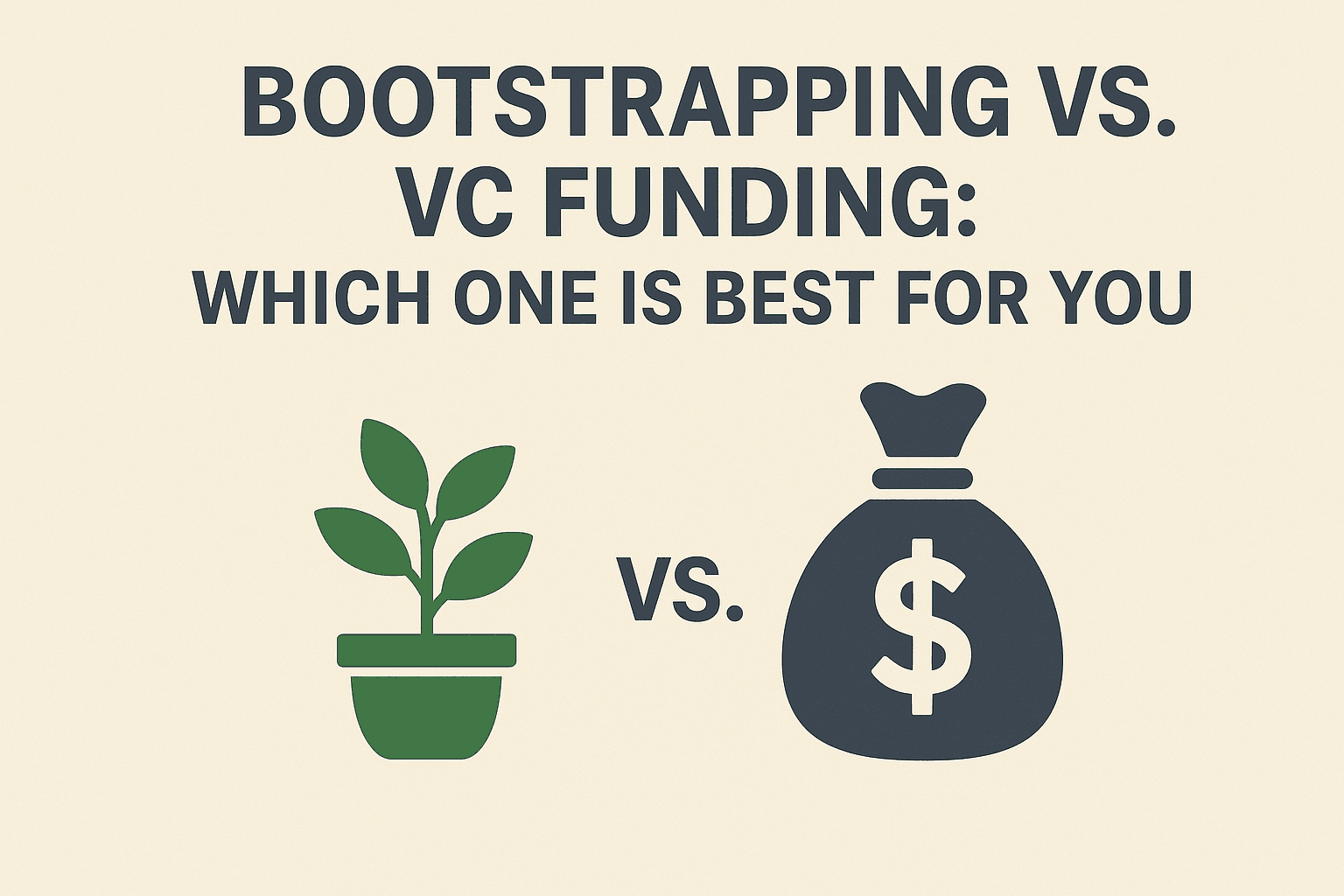Bootstrapping vs VC funding—discover which startup funding option suits your goals. Explore pros, cons, case studies & expert insights with Xane Solutions.
Introduction
One of the most important decisions a startup founder makes early in their journey is how to fund their business. Financing isn’t just about getting money—it directly impacts your company’s control, growth pace, ownership, and long-term direction. For many entrepreneurs, the two primary choices are bootstrapping (self-funding) or raising venture capital (VC).
Both options have led to wildly successful companies. On one hand, companies like Mailchimp and Basecamp built billion-dollar businesses without external investors. On the other, giants like Uber, Airbnb, and Facebook scaled globally thanks to venture capital.
But the path that’s right for one founder may not be right for another. At Xane Solutions, we often guide founders through this decision, and what we’ve seen is clear: your funding choice should depend on your business model, market, growth goals, and appetite for risk.
This blog is your ultimate guide to understanding Bootstrapping vs VC Funding. We’ll dive into the advantages, disadvantages, real-world case studies, decision-making frameworks, and frequently asked questions to help you decide which is best for your startup journey.
What is Bootstrapping?
Bootstrapping is when a founder finances their company using personal savings, revenue generated by the business, or small contributions from family and friends. The phrase comes from “pulling oneself up by one’s bootstraps,” and that’s exactly what entrepreneurs do—they rely on grit, creativity, and limited resources to grow their businesses.
✅ Advantages of Bootstrapping
- Full Ownership & Control
When you bootstrap, you don’t give away equity or decision-making power. You own 100% of your business and have complete authority over direction and vision. - Customer-Centric Growth
Since you can’t burn through investor cash, you’re forced to generate revenue early. This makes you laser-focused on creating value for your customers. - Financial Discipline
With limited resources, you naturally learn how to be frugal and efficient. This builds strong financial habits that serve you well long-term. - No Investor Pressure
Venture-backed founders often face board meetings, reporting requirements, and pressure to scale at all costs. Bootstrappers can grow at their own pace.
❌ Disadvantages of Bootstrapping
- Slower Growth
Without external capital, scaling takes more time. Competitors with funding might outpace you in fast-moving industries. - Personal Risk
Most bootstrappers pour in personal savings or even take loans. If the business fails, the financial impact is direct and personal. - Limited Network & Resources
VC funding often comes with mentorship, partnerships, and publicity. Bootstrapped founders must build these networks on their own. - Scaling Challenges
Entering new markets, hiring aggressively, or investing in R&D is difficult with self-funding alone.
What is Venture Capital (VC) Funding?
Venture capital is money provided by professional investors in exchange for equity in your startup. VCs typically invest in high-growth companies with scalable business models and the potential to deliver outsized returns.
✅ Advantages of VC Funding
- Rapid Growth & Expansion
With millions of dollars in capital, startups can hire faster, enter new markets, and scale much quicker than bootstrapped companies. - Expertise & Networks
Many VCs are experienced operators who provide guidance, mentorship, and connections to partners, customers, and talent. - Reduced Personal Risk
Unlike bootstrapping, you don’t need to drain your personal savings. The financial risk shifts to investors. - Credibility & Visibility
Securing VC funding often signals credibility to customers, media, and potential hires.
❌ Disadvantages of VC Funding
- Loss of Control
In exchange for funding, you give up equity and decision-making power. Major business decisions may require investor approval. - Pressure for Hypergrowth
VCs need big returns. This means aggressive growth targets and pressure to scale even when it might not be sustainable. - Dilution of Ownership
Each funding round reduces your ownership stake. Many founders end up with minority shares in their own companies. - Not Accessible to All
VC funding is highly competitive. Only a small percentage of startups successfully raise capital.
Bootstrapping vs. VC Funding: Key Factors to Consider
1. Business Model
- Bootstrapping works best for service-based businesses, consultancies, and niche products where early revenue can cover expenses.
- VC Funding works best for startups with scalable, tech-driven models that need significant upfront investment (AI, SaaS, biotech, etc.).
2. Growth Goals
- If you want steady, organic growth → Bootstrapping is the way.
- If you want to dominate global markets quickly → VC Funding is more suitable.
3. Risk Appetite
- Bootstrapping carries personal financial risk but gives long-term control.
- VC spreads risk but places enormous performance expectations.
4. Market Opportunity
- Smaller or niche markets can thrive bootstrapped.
- Large, fast-moving, competitive markets often require VC funding to survive.
5. Founder’s Vision
- Do you want to build a profitable lifestyle business that sustains you? Bootstrapping.
- Do you want to build a unicorn startup aiming for billions? VC funding.
Bootstrapping vs. VC Funding: A Side-by-Side Comparison
| Factor | Bootstrapping | VC Funding |
|---|---|---|
| Ownership | 100% Yours | Shared with investors |
| Speed of Growth | Moderate | Rapid |
| Risk | Personal | Shared but pressured |
| Control | Full | Partial (board oversight) |
| Best Suited For | Service-based, niche markets | High-growth, tech-driven businesses |
| Funding Availability | Limited | Large pools of capital |
| Exit Options | Optional | Often IPO or acquisition required |
Real-World Case Studies
Bootstrapped Success Story: Mailchimp
Mailchimp started as a side project in 2001 and was fully bootstrapped for 20 years. By focusing on profitability and customer needs, it grew into a global email marketing leader, generating over $800 million annually before being acquired by Intuit for $12 billion.
VC-Backed Success Story: Uber
Uber raised billions in venture funding to rapidly expand across the globe. This funding allowed them to subsidize rides, enter new markets aggressively, and outcompete rivals. However, it also brought challenges, including investor pressure and regulatory battles.
The Hybrid Approach: Can You Do Both?
Yes! Many startups begin bootstrapped and later raise VC funding once they have traction. This approach allows founders to:
- Prove their business model before dilution.
- Secure better terms with investors.
- Build early discipline and customer focus before scaling.
Examples include Shopify, which bootstrapped for several years before raising funding to accelerate growth.
FAQs
1. Is bootstrapping better than VC funding?
Neither is universally better—it depends on your business model, goals, and industry. Bootstrapping gives control, while VC provides speed.
2. Can I switch from bootstrapping to VC later?
Yes! Many founders bootstrap initially, then raise VC once they’ve proven traction.
3. Do all startups need VC funding?
No. In fact, most businesses worldwide are bootstrapped. VC is mainly for high-growth tech ventures.
4. What if I fail while bootstrapping?
The risk is personal financial loss. However, the lessons in lean growth and discipline are invaluable for future ventures.
5. What’s the biggest mistake founders make in funding?
Chasing VC before validating their product-market fit. Funding doesn’t fix a weak business model.
Conclusion
The debate of Bootstrapping vs. VC Funding is not about right or wrong—it’s about what’s right for YOU.
- If you value independence, want to grow sustainably, and are comfortable with personal risk → Bootstrapping may be your best choice.
- If you want to disrupt industries, scale fast, and aim for a billion-dollar exit → VC funding might be necessary.
At the end of the day, funding is a tool. Execution, customer focus, and resilience matter far more than where the money comes from.
At Xane Solutions, we help founders navigate these decisions, craft growth strategies, and build powerful digital campaigns to scale their ventures.
📍 Visit us at Malviya Nagar, Jaipur, Rajasthan 302017
📞 Call: +91-7597863555 | +91-9680059733
🌐 www.xanesolutions.com
📲 Follow on Instagram: @xanesolutions




